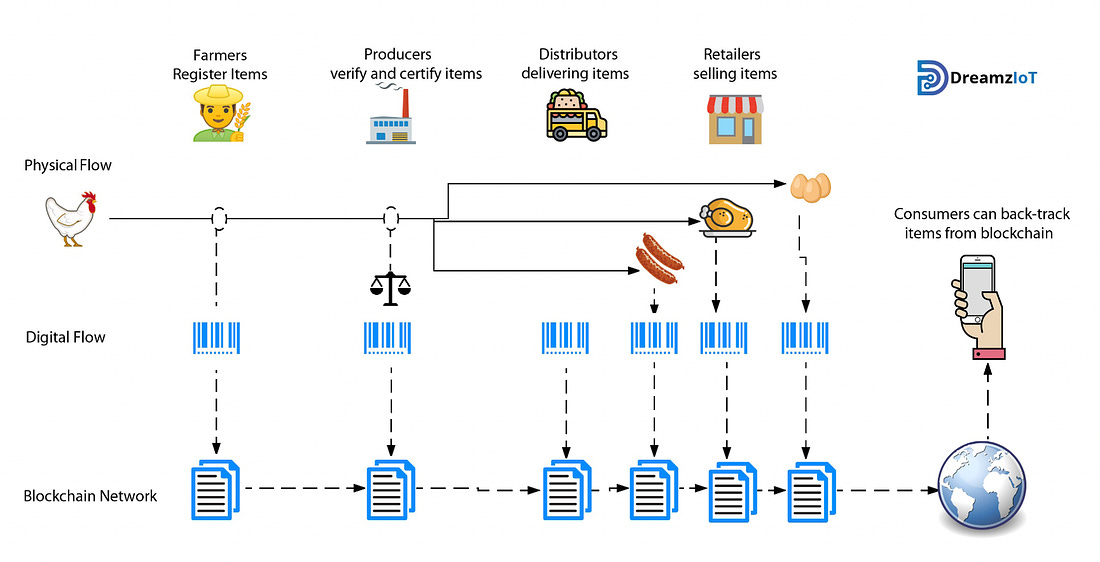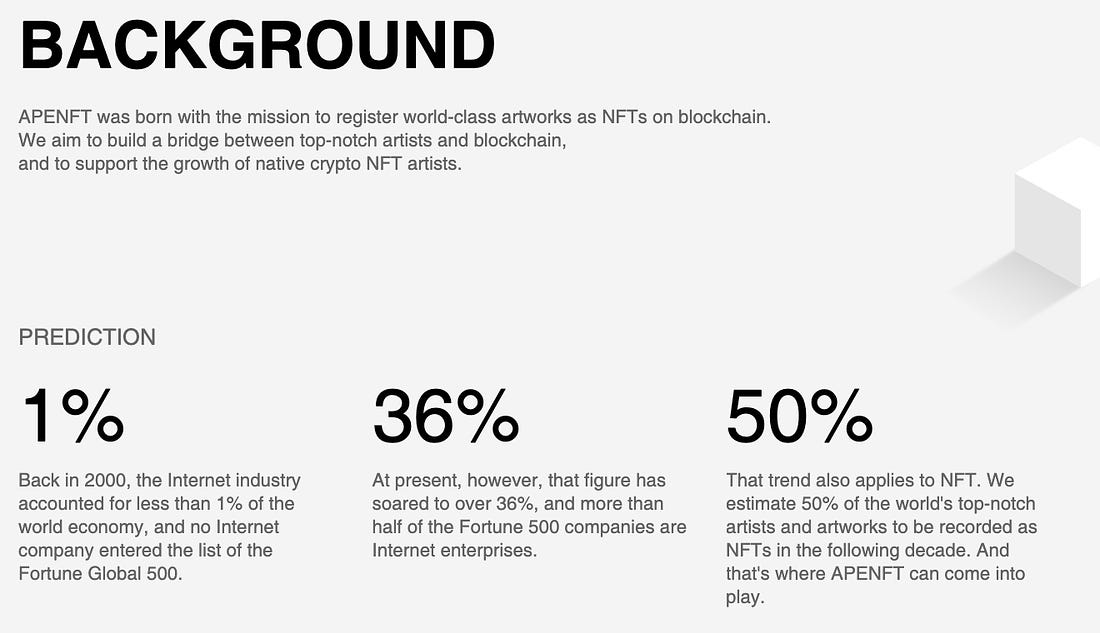In collaboration with Charles Wekselbaum a specialty food manufacturer.
Contents:
🍛 Can Blockchain make our Food better?
👀 Under the Radar
📰 ICYM
👊 Sponsors
💸 Coupons
🍛 Can Blockchain make our Food better?
By Charles Wekselbaum. - charlitoscoina.com
Truth be told, I didn’t pay much attention to blockchain technology/the crypto world when I first heard about back around 2016. Not that I was skeptical or didn’t believe in it, or anything like that. I was simply too wrapped up in my own world, too micro focused on what I was doing, which was, and remains, running a specialty food manufacturing and distribution business. In retrospect, I should have paid more attention. But that’s neither here nor there.
The important part is I’ve realized that, even if it’s hard to pay attention to- perhaps because it’s overly complicated, changing too quickly, too hard to understand, too seemingly inaccessible, etc. etc -it is worth it. For many reasons. In my case though, I can speak specifically on how blockchain technology and cryptocurrency has the potential to make the food industry more transparent and more democratic.
Let’s start with transparency. Blockchain technology has enabled the possibility for every food product to be fully traceable through every step of the supply chain – from the seeds of the raw materials, to production, to distribution – on an immutable “chain” of “blocks,” which is to say, a stream of data that can’t be manipulated. It offers the potential for the most detailed access to information about the food we eat, in a way the mitigates the risk of producers lying to the public about claims pertaining to the food. It is, in essence, better and verifiable information coupled with checks balances.
 From Dreamziot - Transforming food supply chain with Blockchain and IoT
From Dreamziot - Transforming food supply chain with Blockchain and IoT
This is a far cry from what exists today, which is, essentially, taking words expressed on a label or a social media page, at face value, with nothing actually supporting the value of those words except a seemingly baseless proclivity to trust those words, and a relatively anonymous force behind them (i.e. how often do people actually try to verify who writes claims on a label, and if they are true?). Consumers are more inclined to trust attractive packaging and well produced content to inform their purchases, likely because the access to verifiable information that educates a person as to what they are actually buying Blockchain technology can change this. With a simple scan of a QR code on a food product, the entire life cycle of that product becomes visible, accessible, verifiable, and unchangeable in an instant.
Speaking of a baseless proclivity to trust words on a piece of paper, cryptocurrencies such as BTC, ETH, etc. etc. have the potential to disrupt the currently deeply inequitable dissemination of money in the food world. Contrary to the main source of currency in the food industry (i.e. fiat currencies), which are based on little other than trust in a central government, cryptocurrencies are based on verifiable information that cannot be manipulated by any one party. This brittleness has helped fuel an industry that has one of the highest rates of economic disparity, insecurity, and volatility in the world.
The people who make, pick, sell, and transport the food that we all rely on every day are some of the most poorly compensated people in the entire work force. To add insult to injury, by limiting monetary compensation to fiat currencies, those who make It possible for food to appear on our plates are forced to participate in a system in which they have little to no say, inadvertently exposing a vulnerable workforce to a set of regulations that make it nearly impossible to earn a little.
This applies to business and worker alike. It is an industry that tries to convince its workers that a $15 minimum wage in a currency whose value either stays flat or decreases, is a thing to celebrate and accept as adequate, all the while offering little sustainable path to financial security. To help mitigate the difficulty in making a living being paid what most food workers earn, many small businesses and employees resort to transacting salary in cash, a practice that, while sometimes marginally more useful than “on the books,” increases the likelihood of marginalization by reducing access to benefits. Cryptocurrency offers an alternative to participating in a system in which the socioeconomic status of most food workers precludes thriving in, a system that being paid “market rate” usually means living close to the poverty line. Crypto offers a more viable road to economic security than fiat, as it removes the power of currency control out of the hands of a select few who are largely immune from effective oversight, and into the hands of a neutral ledger than is far less easily manipulated, has superior growth potential, and comes with far fewer burdens.
The objective of the perfect food supply Chain system
Traceable
Maintain safety and quality of food products
Adequate communication between all involved parties
Minimizing supply chain cost to make food affordable
Track and control inventory in warehouses and stores
Ultimately, one of the most difficult parts of seeing the potential for cryptocurrency and blockchain to vastly improve the food system, one needs to suspend much of the financial and infrastructural framework that we have all been indoctrinated in, in order to make space for a vastly different perspective. As the saying goes, “old habits die hard.” But without making a concerted effort to step out of the deeply seeded familiarity of the current system, we would miss a major opportunity for improvement. And, if you don’t do it, someone else likely will.
👀 Under the Radar
Osmosis (OSMO) - Osmosis is a decentralized peer-to-peer blockchain that people can use to create liquidity and trade IBC enabled tokens (Inter-Blockchain Communication Protocol (IBC) allows independent blockchains to directly communicate and trade assets). The Osmosis blockchain is made up of free, public, and open-source software.
Alchemix (ALCX) - DeFi platform. Alchemix presents a new way of paying back debt. It uses the yield earned from the deposit to amortize the users’ debt. The longer you leave your deposit, the more yield you can earn and consequently have more of your loan paid back.
ANYSwap (ANY) - Network that have entered the DeFi space to facilitate cross-token swaps and trading. An overwhelming majority of cryptocurrencies — 95% of them to be exact — have incorporated Anyswap, including the likes of XRP, Litecoin and Tether. Anyswap is able to better manage the flow of movement of tokens between blockchains. Powered by Fusion Network which uses a process known as private key sharding — where the private key is split up into several bits and managed by various network nodes — to guarantee assets are safe. The different parts of the private key are never combined during transfers or trading to boost security.
Smart contracts on Anyswap are open source, a factor which enhances security using individual audits.
The ANY token also enables holders the freedom to determine which coins are most appropriately suited to be listed on the Anyswap DEX, its decentralized exchange.
ApeNFT (NFT) - Core businesses of APENFT include: investing in top NFT platforms and artworks, incubating leading NFT artists to build a bridge between world-class artists and the NFT world.
It provides support to government agencies, universities, lawyers and industry elites in issuing policies that govern the healthy development of the industry.
Harmony (ONE) - Focusing on processing speed and validation, the Harmony mainnet aims to revolutionize block creation. By introducing the sharding process, the company reduced node validation times significantly. To ensure the protection of nodes and secure the validation process, nodes and validators are assigned and re-assigned in a randomized manner. It uses effective proof-of-stake (EPoS), this method allows simultaneous staking from hundreds of validators.
📰 ICYM

